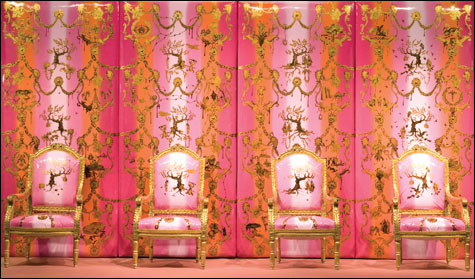
"CLEARANCE: THE FOUR HORSEMEN" Antique gilt wood chairs, upholstery vinyl, foam, acrylic
paint, permanent marker, 96x180x36 inches, by Greta Bank, 2007.
Juried shows are a terrible idea. The problem is, if you’re interested in doing a survey show and don’t have the resources to send a team of curators around to see everything, there’s no other way to do it. If you had one person doing the choosing maybe you’d get consistency, but then it would be about the chooser, not the chosen. That said, I have a nagging feeling that anyone who would be willing to serve on a survey-show jury should be automatically disqualified.
These thoughts accompanied me through the big biennial show at the Center for Maine Contemporary Art in Rockport, a venerable institution that has evolved over the years from a summer-showing barn to quite a polished exhibition venue.
This year there’s a color catalog, with the now-inevitable artist statements appearing with the images, as if each artist were postulating a thesis instead of joining with the viewer in a process of discovery.
The nature of survey shows is that you have to go see them, and this is no exception. There are some familiar figures: John Whalley, Shoshanna White, Henry Wolyniec, Jeff Kellar, Don Meserve, to name a handful. There are also some people with fairly short exhibition histories, just getting started in their careers, and more who are sort of in-between. You can’t really tell much about the state of things from a survey show, but you do get a flavor of what artists, in this case close to 90 of them, are thinking about.
Lots of them are thinking about the same things as other artists around the country. Sometimes this show felt like the review pages of, say, ARTnews. No surprise, what gets attention draws more attention. There are a few installations, obligatory in today’s world; the photography is mostly digital; and many of the works that are hung like paintings are constructions. There are, in fact, relatively few paintings, but since paintings are drawing more attention in the New York art world these days, I suspect the next biennial will see more.
The job of the interested viewer in such a big show is to seek out a few works with a distinct voice of their own.
Greta Bank’s creepy installation "Clearance: The Four Horsemen" has four large pink upholstered plastic panels behind four gilt chairs with the same upholstery. The plastic has been painted on the inside with baroque patterns and eschatological imagery. It’s like the decoration in a gaudy cheap New Jersey diner in hell.
Tyler McPhee’s installation is a back-country museum about Bigfoot, complete with videos from television shows and a very dumb Bigfoot documentary, cheap fiction books, magazines, casts of Sasquatch footprints, and even a little collection jar for support. It’s a funny work, a little sad, and an exercise in how myths make themselves.
Elke Morris’s photograph "Independence Day" is a wide panoramic view of a mill town taken from across a river. There’s an old brick mill building on the left, and on the right there’s a gathering of people and tents, obviously some celebratory event. The mill building and the crowd are in sharp focus while the rest of the town is fuzzy and soft. It gives the whole scene an unreal quality, as if these were model buildings and people in a little diorama. It’s an odd effect, making the event seem lonely and isolated.
Two more pieces, both of them by artists unafraid of enigma, are by Ethan Andrews and Debra L. Arter. Arter’s unpretentious "Book of Bacon" was made by running an inked bacon package through a printmaker’s press, resulting in a simple book-like image with a medieval cast. Ethan Andrews, in "Three Puzzles," has grouped three odd objects that seem like they must be related but it’s hard to tell why.
2008 BIENNIAL JURIED EXHIBITION at Center for Maine Contemporary Art, 162 Russell Ave, Rockport | through October 4 | 207.236.2875 |www.cmcanow.org
Ken Greenleaf can be reached atken.greenleaf@gmail.com.